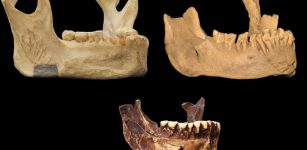Face Of Pictish Man Brutally Murdered 1,400 Years Ago – Reconstructed
MessageToEagle.com – Some 1,400 years ago, a Pictish man was brutally murdered and his skeleton was recently discovered in a cave on the coast of the Black Isle peninsula, in the Scottish Highlands.
Archaeologists found evidence that the cave had been used for iron-smithing during the Pictish period. The body had been placed in an unusual cross-legged position, with large stones holding down his legs and arms.

The bones, sent to the Center for Anatomy and Human Identification at the University of Dundee, were analyzed by a team of researchers led by CAHID’s world-renowned forensic anthropologist Professor Sue Black.
See also:
Picts: Facts And History About Mysterious People Of Northern Scotland
Dandaleith Stone: Scotland’s Rare Symbol Stone Of The Picts – Will It Be Deciphered Now?
Inchbrayock Stone: Pictish Samson Stone Carved With Biblical Symbols And Scenes
Face Of Mighty King Of Scots – Robert The Bruce Reconstructed
Dundee University research team was also able to reconstruct the face of the man.
Examination of the Pictish murder victim revealed that he had suffered from at least five severe head injuries and he died a violent death.
“The first impact was by a circular cross-section implement that broke his teeth on the right side,” said Professor Black said.
“The second may have been the same implement, used like a fighting stick which broke his jaw on the left. The third resulted in fracturing to the back of his head as he fell from the blow to his jaw with a tremendous force possibly onto a hard object perhaps stone.
“The fourth impact was intended to end his life as probably the same weapon was driven through his skull from one side and out the other as he lay on the ground. The fifth was not in keeping with the injuries caused in the other four where a hole, larger than that caused by the previous weapon, was made in the top of the skull.”

Radiocarbon dating of a bone sample indicates that he died sometime between 430 and 630 A.D., during the so-called Pictish period in Scotland.
“Having specialized in prehistoric cave archaeology in Scotland for some years now, I am fascinated with the results,” excavation leader Steven Birch said.
“Here, we have a man who has been brutally killed, but who has been laid to rest in the cave with some consideration –placed on his back, within a dark alcove, and weighed down by beach stones.
“While we don’t know why the man was killed, the placement of his remains gives us insight into the culture of those who buried him. Perhaps his murder was the result of interpersonal conflict; or was there a sacrificial element relating to his death?”
MessageToEagle.com
Expand for references









